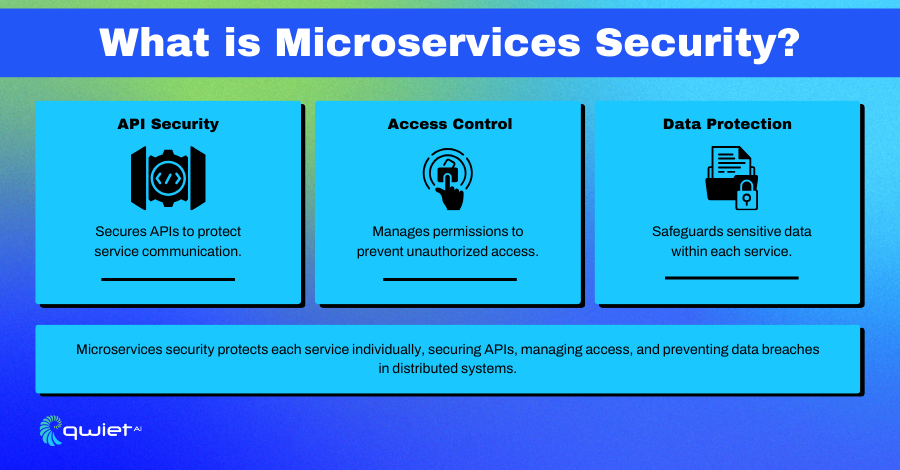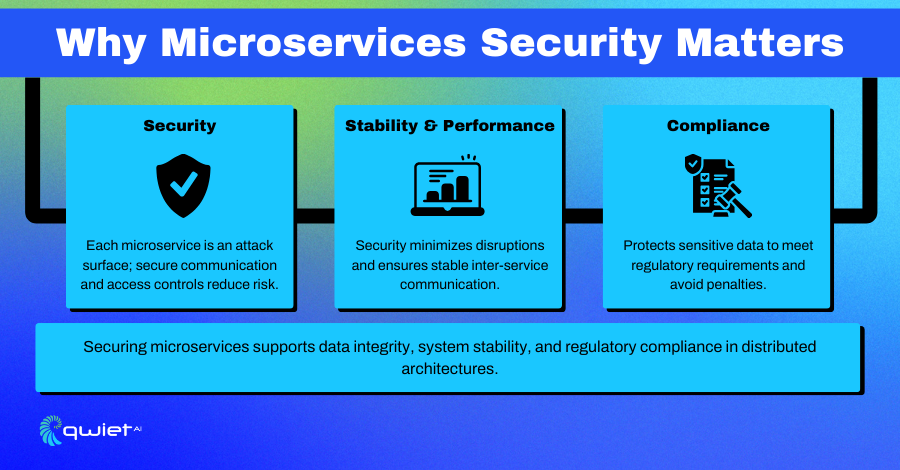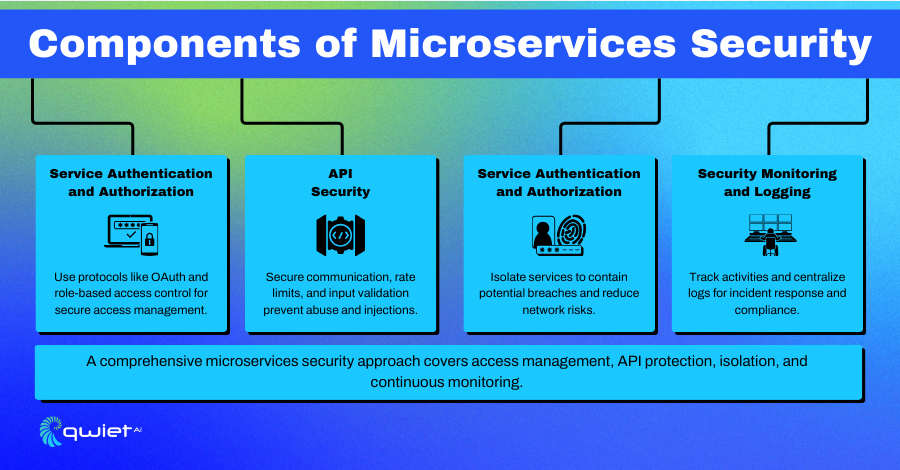What is Microservices Security?

Microservices security is the comprehensive approach to safeguarding each service within a microservices architecture. In this model, each service functions independently, which creates unique security requirements for each one. To secure these distributed services, microservices security involves methods to protect inter-service communications, secure APIs, and manage access and identity across multiple services within the system.
The main objectives of microservices security are to prevent unauthorized access, protect sensitive data, and ensure distributed applications’ secure, reliable operation. By implementing security at each architecture level, microservices help reduce the risk of breaches, minimize potential disruptions, and support the consistent operation of services across the system.
Why Microservices Security Matters

Security
Each microservice operates as an individual unit within the architecture, presenting its potential attack surface. This unique setup increases the overall exposure to potential threats. If one microservice is compromised, it could lead to unauthorized access to other connected services. Ensuring secure communication and strict access controls across services is essential to reducing the risks of data breaches, unauthorized data access, and potential service compromise.
Stability & Performance
The stability and performance of a microservices architecture depend on secure and consistent communication between services. Security vulnerabilities can lead to performance issues, cascading failures, or even system outages. By implementing strong security measures, organizations can enhance the stability of their microservices, reducing downtime and maintaining smooth operations even in the face of potential threats.
Compliance
Many industries have strict regulations governing data security and handling, especially concerning personal or financial information. Standards like GDPR, HIPAA, and PCI-DSS mandate secure data handling and access controls. Adopting best practices in microservices security helps organizations align with regulatory requirements, reducing the risk of fines or penalties while ensuring compliant data protection practices.
Components of Microservices Security

Service Authentication and Authorization
Authentication ensures that only legitimate users and services can access each microservice. Common protocols such as OAuth, JWT, and OpenID Connect are often used. Authorization then defines specific permissions for users or services, determining what resources they can access. Role-based access control (RBAC) or attribute-based access control (ABAC) are frequently used to enforce these permissions, providing a structured way to manage access across the system.
API Security
Secure Communication is essential for protecting data as it travels between services. Encrypting data in transit with HTTPS/TLS protocols helps secure these communications. Rate Limiting and Throttling manage the number of requests made to APIs, helping to prevent abuse and maintain stability. Additionally, Input Validation and Sanitization prevent injection attacks by ensuring that only properly formatted data is accepted, reducing the likelihood of malicious code entering the system.
Service Isolation and Network Segmentation
Isolation involves containing each service to limit the impact of a potential breach, preventing a compromised service from easily affecting others. Network Segmentation further enhances security by using firewalls or microsegmentation to control and limit access within the network. This strategy effectively reduces risk by isolating services and managing interactions within the network.
Security Monitoring and Logging
Continuous Monitoring is vital for tracking the activity of each microservice to detect anomalies and unauthorized access attempts. Centralized Logging gathers logs from all services, providing a comprehensive view of system activity. This aggregated data is invaluable for incident response, compliance reporting, and overall system visibility, helping organizations maintain a proactive security stance.
Conclusion
A strong microservices security strategy is essential for protecting distributed applications from unauthorized access, data breaches, and potential service disruptions. Securing microservices involves safeguarding each service individually, ensuring smooth communication, and continuous monitoring to detect potential threats quickly. For organizations looking for a comprehensive security approach, partnering with specialized security solutions or consulting experts can further strengthen the security of microservices architectures, aligning with best practices and regulatory requirements. Book a call to find out how Qwiet can help secure your Micro-Service Security.
Read Next
No related posts.
About Qwiet AI
Qwiet AI empowers developers and AppSec teams to dramatically reduce risk by quickly finding and fixing the vulnerabilities most likely to reach their applications and ignoring reported vulnerabilities that pose little risk. Industry-leading accuracy allows developers to focus on security fixes that matter and improve code velocity while enabling AppSec engineers to shift security left.
A unified code security platform, Qwiet AI scans for attack context across custom code, APIs, OSS, containers, internal microservices, and first-party business logic by combining results of the company’s and Intelligent Software Composition Analysis (SCA). Using its unique graph database that combines code attributes and analyzes actual attack paths based on real application architecture, Qwiet AI then provides detailed guidance on risk remediation within existing development workflows and tooling. Teams that use Qwiet AI ship more secure code, faster. Backed by SYN Ventures, Bain Capital Ventures, Blackstone, Mayfield, Thomvest Ventures, and SineWave Ventures, Qwiet AI is based in Santa Clara, California. For information, visit: https://qwietdev.wpengine.com
